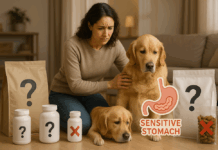Last Updated on April 26, 2022 by Dogs Vets
Can Dogs Eat Garlic?
Before you begin feeding your dog garlic, you need to know how much you should give it.
You should measure the amount of garlic cloves in teaspoons. Keep in mind that the size of the cloves will vary depending on the size of your dog’s mouth.
The amount of garlic you feed should also be adjusted for your dog’s weight, as some varieties have very large cloves. Before you begin, consult an expert for more information.
Symptoms of garlic poisoning in dogs
Unlike humans, dogs cannot break down the elements of garlic. This means that garlic ingested as food is harmful to their health.
Some of the most common symptoms include vomiting, diarrhea, and abdominal pain.
Occasionally, dogs may become lethargic and weak. The condition can also cause rapid heart rate. Although garlic poisoning rarely causes death, the signs of garlic poisoning in dogs should be closely monitored to ensure the best possible treatment.
The most effective method of treating garlic poisoning in dogs is to limit the amount you give your dog.
Avoid giving your pet human food. Instead, make sure that your garden is fenced so that your pets can’t access the vegetables.
Keep an eye out for food scraps, as your dog may vacuum them up. The only way to be sure that your dog is not suffering from garlic poisoning is to visit your veterinarian.
Your dog will most likely have these symptoms even after you’ve removed the food from its mouth.
Despite the severity of garlic poisoning in dogs, the condition rarely causes death in healthy dogs. In most cases, the symptoms go away within a day or two.
However, if your dog doesn’t vomit, Your pet might need to visit the hospital.
If the condition is severe, your veterinarian may suggest giving your dog activated charcoal, which absorbs the garlic toxins and helps the dog recover. If your dog has severe anemia, he or she may even need a blood transfusion.
Sources of organosulfoxides in garlic
In garlic, the health benefits are due to its content of organosulfur compounds. Allicin is the main precursor to the ACSOs, which are oil-soluble polysulfides.
The process of distillation and hydrodistillation converts the alliin into the garlic oil, which contains the compounds allyl methyl trisulfide and 2-vinyl-4H-dithiin.
Allium species have different levels of organosulfides, which affect the flavor of the vegetables. The DADS found in garlic is similar to dimethyl thiosulfonate in Allium, which is responsible for the pungent taste of alliums.
Onions, however, contain high amounts of polysulfides that are derived from allyl methyl sulfate.
The garlic molecule alliin undergoes degradation when exposed to oxygen. The enzymes in damaged tissues cause them to degrade into their constituents.
The first degradation product of alliin is allicin, which decomposes into various oil-soluble compounds.
The second degradation product, ajoene, is more stable and is the main constituent of garlic oil extracts. Both alliin and ajoene have anti-cancer properties and are considered healthy.
Several other compounds from garlic are associated with a sour or fried taste.
Toxicity of garlic to dogs
When you give your dog garlic, he will most likely vomit. He will also lose energy and be lethargic. Your dog will also be anemic, with pale gums and inner eyelids.
Your dog’s body will be unable to pump enough blood and recognize that there is a lack of oxygen in his body. To make up for this, the heart will beat faster and increase its rate. This action will result in anemia.
If you must feed your dog garlic, be sure to follow these precautions. While garlic is highly perishable, a small amount of it may be enough to make your dog gassy.
You should not give your dog garlic bread, as this can cause Garlic toxicity. You can avoid giving your dog garlic bread by fencing your garden to keep out your dog. And keep an eye out for leftover food that may end up on your dog’s floor.
Moreover, your dog can easily vacuum up the scraps that contain garlic. But as always, if you think that your dog has eaten garlic, seek veterinary help.
While garlic can be toxic to dogs, it can have many beneficial effects on humans.
It can lower cholesterol, lower blood pressure, and boost the immune system. However, you should always consult your vet before giving your dog garlic, because the benefits are often dependent on the type and dosage.
A study on garlic and dogs found that garlic can cause hemolytic anemia in dogs. However, the study used only four dogs. Because the study was so small, it was impossible to determine how much garlic a dog could safely consume.
Facts Check
We hope you enjoyed this article… What are your thoughts?
Рleаse feel free to share with us in the comments section below!

















